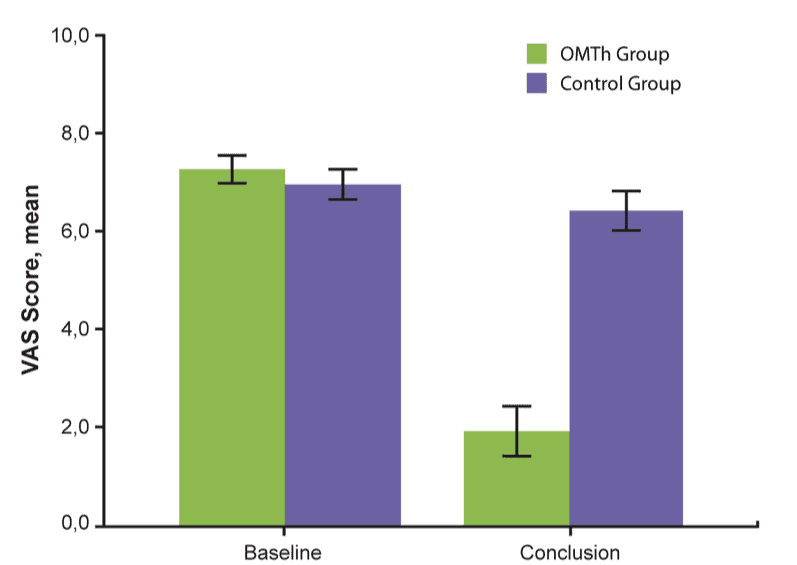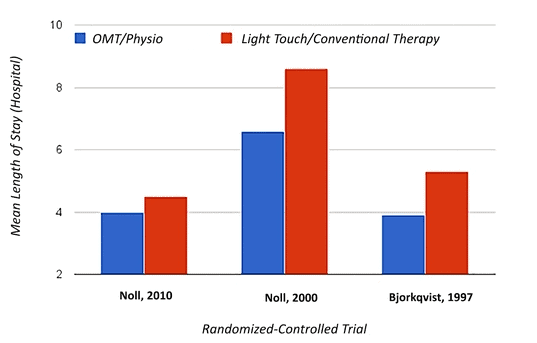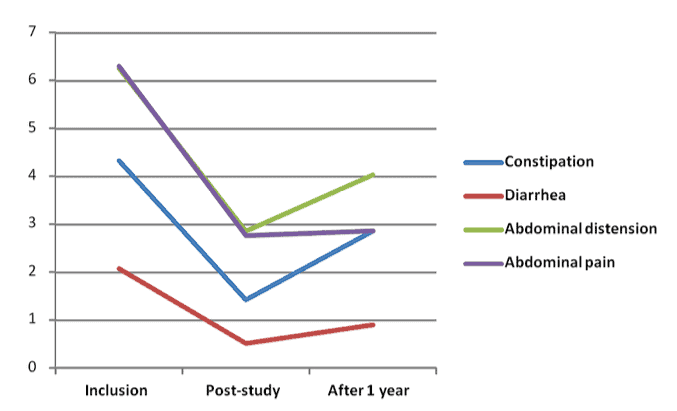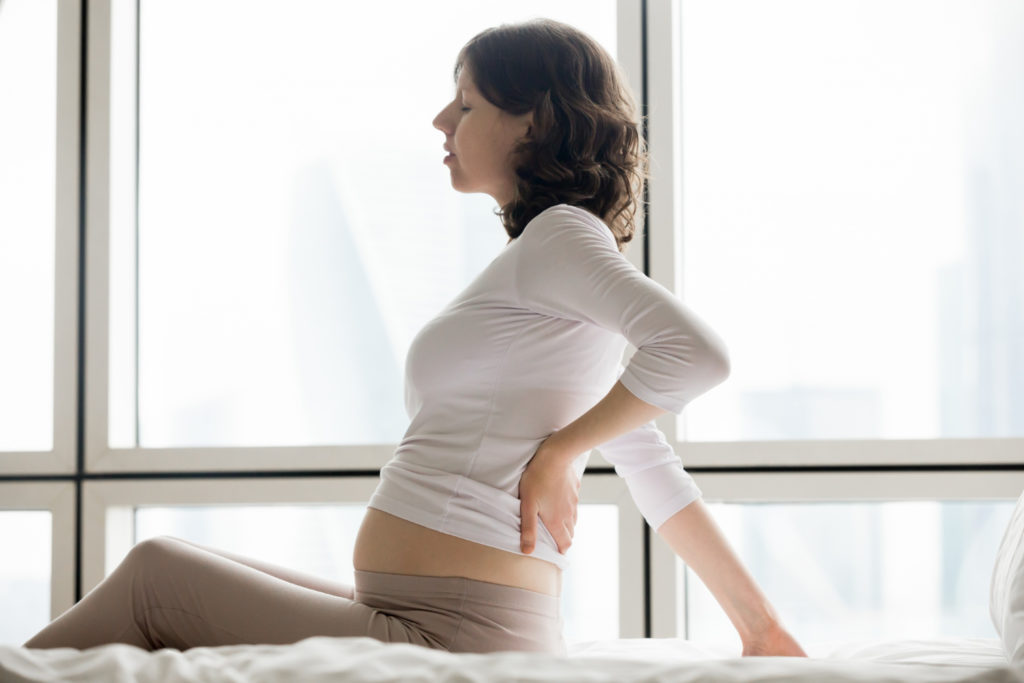
Morgan Hancock
M.Ost, BAppSci (Human Biology & Physiology), BSc, PGCert (Western Medical Acupuncture)
Continuing from the previous article, today we’ll talk about how osteopathy can assist with
- Pregnancy
- Respiratory conditions
- Severe disabilities
- Post-surgical recovery
and other health concerns and issues.
Pregnant women and babies
Pregnancy brings significant changes to the body, often leading to discomfort, back pain, and joint issues.
Osteopathic treatment can help pregnant women adapt to these changes more easily and prepare for birth by improving pelvic alignment and easing muscular tension.[1]
Osteopathy benefits for pregnant women:
- Eases lower back pain and pelvic discomfort
- Supports the body’s adjustments to weight shifts and postural changes
- Prepares the body for labour by improving pelvic mobility
- Supports the body postpartum, to settle the pelvis and realign the body post birth trauma
The figure below illustrates the reduction in lower back pain that postpartum women experienced, using osteopathic treatment.[1]

Both groups started with pain scores around 7/10. While the control group showed little change, the osteopathic treatment group reported a significant reduction, reaching 2/10 after 8 weeks.
For babies, osteopathy can assist in relieving issues such as
- colic
- unsettled sleeping
- general discomfort
particularly when births involve interventions like forceps or vacuum extraction.
Cranial osteopathy, a gentle technique used to work with the infant’s anatomy, is particularly beneficial for addressing these post-birth concerns.[2]
Respiratory conditions
Osteopathy has been shown to help people with respiratory issues such as
- asthma
- pneumonia
chronic obstructive pulmonary disease (COPD)[3]
Techniques that promote better rib cage mobility and improved diaphragm function can support easier breathing and better lung capacity.[4]
Osteopathy supports respiratory health by
- Enhancing lung function by improving chest wall movement
- Reducing tension in the accessory muscles of breathing
- Promoting better oxygen exchange and overall respiratory efficiency

Osteopathy can improve diaphragm function that supports easier breathing
In several randomised controlled trials the time spent in hospital was markedly reduced through the use of osteopathic manual therapies that targeted musculoskeletal restrictions impeding breathing.
Children with severe disabilities
Children with severe disabilities, such as cerebral palsy or autism spectrum disorder, often experience challenges ranging from musculoskeletal pain to digestive issues.
Osteopathic techniques, particularly visceral and cranial osteopathy, have been applied to help manage these symptoms and improve quality of life.[5]
Osteopathy can assist children with disabilities by
- Reducing / relieving pain and discomfort
- Improving digestion and reducing constipation
- Supporting neurological development and overall well-being
Visceral osteopathy focuses on mobilising abdominal organs, stimulating the parasympathetic nervous system, which can influence digestive and cognitive functions.[5]
Cranial techniques work to support cranial nerve function and cerebrospinal fluid flow, potentially benefiting children with neurological disorders.
Osteopathic treatment for children with severe disabilities will never “fix” their underlying conditions but ongoing treatment can help maintain their current physical state.
Post-surgical recovery
Post-operative recovery can be accelerated with osteopathic treatment. Osteopaths help patients regain mobility and improve circulation, which can reduce scar tissue formation and improve overall healing after surgery.[6]
Osteopathy and post-surgical rehabilitation
- Reduces scar tissue and adhesions
- Supports lymphatic drainage to reduce swelling
- Restores joint and muscle function
A study examining the combination of manual lymphatic drainage (MLD) and targeted rehabilitation therapies for women post-breast cancer surgery demonstrated superior outcomes compared to standard care alone.[7]
Patients experienced improved shoulder mobility, reduced scar tissue formation, and faster chest wall drainage, indicating enhanced lymphatic flow and tissue healing. These techniques, commonly used in osteopathic practice, highlight their efficacy in post-surgical rehabilitation.

Stress and anxiety management
Osteopathy, through its holistic approach, can help manage the physical manifestations of stress and anxiety.
Stress causes chemical changes to the body including increases in adrenaline, cortisol and prolactin, all with varying impacts to the body’s systems.
RELATED — Introduction to Anxiety: Know what you are dealing with (Part 1)
Techniques that focus on releasing muscular tension and improving nervous system function are particularly useful in reducing stress-related symptoms.
Osteopathy provides stress relief by
- Improving muscle relaxation and circulation
- Improving nervous system regulation through cranial osteopathy
- Enhancing respiratory function, supporting better oxygenation and relaxation
Osteopathy’s focus on balance within the body can help alleviate the physical strain caused by prolonged stress or anxiety.[8]
A pilot study demonstrated that osteopathic manipulative treatment significantly increases salivary immunoglobulin A (sIgA) levels, a marker inversely related to stress.[9]
Participants under high stress who received osteopathic manipulative therapy (OMT) experienced an average 139% increase in sIgA levels post-intervention.

These findings highlight osteopathic manipulative therapy’s potential to enhance immune function and reduce stress by supporting the body’s physiological responses.
Digestive health
Osteopathic treatment has shown promise in treating common digestive issues like irritable bowel syndrome (IBS). By improving visceral mobility and reducing abdominal tension, osteopathy can aid digestion and promote gastrointestinal health.[10]
Osteopathy can assist with digestive health by
- Relieving tension in the abdominal organs
- Supporting bowel movement and digestive function
- Alleviating symptoms of IBS and other digestive disorders
Osteopathy can promote gastrointestinal health
Visceral osteopathy can significantly improve symptoms like diarrhea, bloating, and abdominal pain. In a study of 31 IBS patients, participants reported significantly fewer issues with diarrhea, bloating, and abdominal pain compared to the start of the trial.[11]

By addressing structural restrictions within the abdomen, osteopathy helps restore normal digestive function and relieve symptoms.
Conclusion
Osteopathic treatment offers a wide range of health benefits, addressing both acute and chronic conditions through an approach that focuses on the body’s natural ability to heal itself.
From managing pain and improving mobility to supporting respiratory health and post-surgical recovery, osteopathy plays a crucial role in maintaining long-term wellness.
Related Questions
1. Can an osteopath release a trapped nerve?
Yes, osteopaths can help trapped nerves through manual techniques such as joint mobilisations, soft tissue release, and nerve “flossing”.
This alleviates compression, reduces inflammation, and improves mobility for the nerve.
2. What are the main differences between osteopathy and chiropractic manipulation?
While osteopaths and chiropractors share similar manipulation techniques, osteopaths integrate them with other treatments (e.g., soft tissue, mobilisation, muscle release) for recovery.
Chiropractors often emphasise manipulation alone and may promote extended treatment plans.
3. What not to do after an osteopathic treatment?
After osteopathic treatment, avoid intense physical activity (e.g., running), heavy lifting, or gym workouts. Hydrate well, rest, and allow your body to adjust to the treatment’s effects for optimal recovery.
If you have just joined us, we suggest reading the first part of this topic — The Health Benefits of Osteopathic Treatment (Part 1).
References
(1) Schwerla, F., Rother, K., Rother, D., Ruetz, M., & Resch, K.-L. (2015). Osteopathic manipulative therapy in women with postpartum low back pain and disability: A pragmatic randomized controlled trial. Journal of Osteopathic Medicine, 115(7), 416–425. DOI: 10.7556/jaoa.2015.087
(2) King, H. H., Mai, J., Morelli Haskell, M. A., Wolf, K., & Sweeney, M. (2024). Effects of osteopathic manipulative treatment on children with plagiocephaly in the context of current paediatric practice: a retrospective chart review study. Journal of Osteopathic Medicine, 124(4), 171–177. DOI: 10.1515/jom-2023-0168. https://www.degruyter.com/document/doi/10.1515/jom-2023-0168/html
(3) Yao, S., Hassani, J., Gagne, M., George, G., Gilliar, W. Osteopathic Manipulative Treatment as a Useful Adjunctive Tool for Pneumonia. J. Vis. Exp. (87), e50687, doi:10.3791/50687 (2014). https://www.jove.com/t/50687/osteopathic-manipulative-treatment-as-useful-adjunctive-tool-for
(4) Rocha, H.M.; Muniz De Souza, H.C.; Viana, R.; Neves, V.R.; Dornelas De Andrade, A. Immediate Effects of Rib Mobilization and Diaphragm Release Techniques on Cardiac Autonomic Control in Patients with Chronic Obstructive Pulmonary Disease: A Pilot Study. J. Chiropr. Med. 2020, 19, 167–174. DOI: 10.1016/j.jcm.2020.06.001
(5) Tarsuslu, T., Bol, H., Şimşek, İ. E., Toylan, İ. E., & Çam, S. (2009). The effects of Osteopathic treatment on constipation in children with cerebral palsy: A pilot study. Journal of Manipulative and Physiological Therapeutics, 32(8), 648–653. DOI: 10.1016/j.jmpt.2009.08.016
(6) Gugel, M. & Johnston, W. (2006). Osteopathic Manipulative Treatment of a 27-Year-Old Man After Anterior Cruciate Ligament Reconstruction. Journal of Osteopathic Medicine, 106(6), 346-349. https://doi.org/10.7556/jaoa.2006.106.6.346
(7) Xiong, Q., Luo, F., Zhan, J., Qiao, J., Duan, Y., Huang, J., Li, R., Liu, H., & Jin, P. (2022). Effect of manual lymphatic drainage combined with targeted rehabilitation therapies on the recovery of upper limb function in patients with modified radical mastectomy: A randomized controlled trial. Turkish journal of physical medicine and rehabilitation, 69(2), 161–170. https://doi.org/10.5606/tftrd.2023.11221
(8) Roberts, A., Harris, K., Outen, B., Bukvic, A., Smith, B., Schultz, A., Bergman, S., & Mondal, D. (2022). Osteopathic Manipulative Medicine: A brief review of the hands-On treatment approaches and their therapeutic uses. Medicines, 9(5), 33. https://doi.org/10.3390/medicines9050033
(9) Thibaut D, Santarlas V, Hoppes J, Vásquez-Castillo A, Morrow A, Oviedo E, Toldi J. Osteopathic Manipulation as a Method of Cortisol Modification: A Systematic Review. Cureus. 2023 Mar 29;15(3):e36854. doi: 10.7759/cureus.36854.
(10) Lotfi C, Blair J, Jumrukovska A, Grubb M, Glidden E, Toldi J. Effectiveness of Osteopathic Manipulative Treatment in Treating Symptoms of Irritable Bowel Syndrome: A Literature Review. Cureus. 2023 Jul 24;15(7):e42393. doi: 10.7759/cureus.42393. https://pmc.ncbi.nlm.nih.gov/articles/PMC10446503/
(11) Attali, T. V., Bouchoucha, M., & Benamouzig, R. (2013). Treatment of refractory irritable bowel syndrome with visceral osteopathy: short-term and long-term results of a randomized trial. Journal of digestive diseases, 14(12), 654–661.






